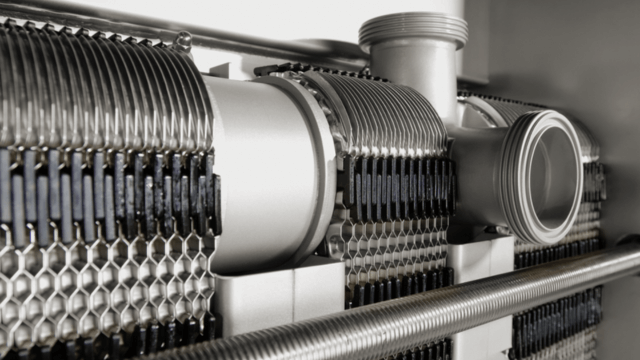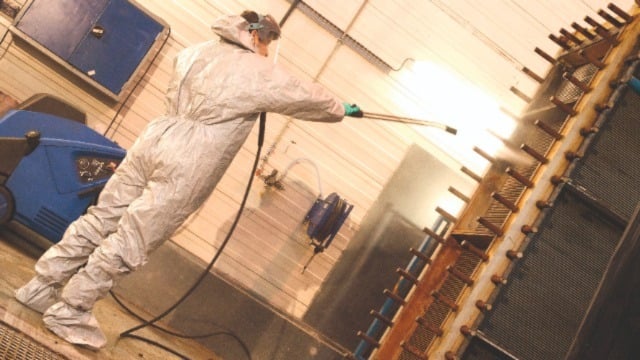Why You Need to Clean Your Plate Heat Exchangers
Heat exchangers are used in industrial applications to transfer heating or cooling from one gas or liquid to another.
DATE 2024-02-27
Heat exchangers are used in various industrial applications to transfer heating or cooling from one gas or liquid to another, helping to cut costs, recycle heat and optimize energy consumption. But matching the right technology to your specific conditions ensures optimal performance and energy-efficiency.
Plate heat exchangers are designed to optimize heat transfer—far better than conventional heat exchangers—since the corrugated plates provide the greatest surface area through which the heat can be drawn from one gas or liquid to the other.
There’s a wide range of plate heat exchangers on the market, but finding the best match can help you optimize uptime, improve operations and reach your sustainability goals faster. So once you find the right product, you’ll want to make sure it continues to operate at peak performance.
Why it’s important to service your heat exchangers
Are you getting the most from your heat exchangers? Do you know how they’re performing and what condition they’re in? Knowing the answers to these questions—either through condition auditing or analyzing data from your process—will help you meet your business needs.
Cleaning your plate heat exchangers helps to:
- Keep your process in optimal condition
- Minimize planned and unplanned downtime
- Maintain optimal performance of your plate heat exchanger
- Minimize energy consumption to reduce your carbon footprint
A poorly functioning heat exchanger could affect safety, product quality and energy costs, and an unexpected event may lead to costly downtime and major losses in production.
When should a plate heat exchanger be cleaned?
Waiting for visible signs of problems before servicing your heat exchanger can result in inefficiency of the unit, increased energy losses and unplanned shutdowns. Cleaning should be done before complete fouling or process issues occur, which could cause irreversible damage.
On the other hand, if you clean your heat exchangers too often, you could end up lowering productivity.
All heat exchangers lose performance over time. Even if your heat exchanger allows for in-place cleaning, it’s still recommended to send your units for reconditioning on a regular basis to reset their status to an as-good-as-new condition.
A performance audit verifies your plate heat exchanger is performing according to design specifications and helps identify areas where performance can be improved.
Why choose Alfa Laval for your cleaning service?
Plate heat exchangers can be cleaned either on-site or off-site, and our service advisors can recommend the best solution for your specific equipment.
While Alfa Laval produces a wide range of plate heat exchangers, we can service any brand, including AGC, API Schmidt, APV, Armstrong, Arsopi, Bell & Gossett, Funke, GEA, Graham, ITT, Kelvion, Sondex, SPX, Swep, Tranter and WCR.
Our cleaning service includes:
- Mechanical cleaning: washing the equipment (on-site or off-site)
- Cleaning-in-Place (CIP): quick and easy inline cleaning, without dismantling the heat exchanger
- Cleaning chemicals: specially developed non-toxic agents that safeguard gasket, glue and heating surface materials
How the cleaning and reconditioning process works
We inspect your heat exchanger for major corrosion, deformities and erosion—if possible, we’ll recondition plates rather than replace them. Gaskets are carefully removed with liquid nitrogen at -196°C, ensuring that no damage is done to the plate. Deposits and residue on plates are then removed in a series of chemical baths and hydro-jet washing, without risk of environmental contamination.
From there, we’ll do a secondary inspection for defects, which includes a thorough search for plate deformation in grooves and contact points, as well as erosion of plate surfaces. This step ensures that no defective plates are put back into service. A dye penetrant and ultraviolet light test is used to detect cracks and pinholes that lead to cross-contamination; plates that fail this inspection are replaced with new ones.
Gaskets are then attached using original factory procedures (the grade of gasket is chosen based on the media, pressure and temperatures). The glue used for glued gaskets is a two-part epoxy that is carefully oven-cured to ensure optimal bonding between the plates and the gaskets.
When complete units are sent to an Alfa Laval service centre, a hydro-test ensures the reconditioned plates meet the unit’s pressure requirements, and a hydro-test certificate is issued by Alfa Laval.
With regular and proactive maintenance, your plate heat exchangers will be restored to optimal condition, which in turn will lower your maintenance costs and extend your equipment’s lifetime. And by saving energy, you can lower your operating costs as well.
Alfa Laval has more than eight decades of experience in thermal transfer. Contact us to speak to one of our heat exchanger experts or schedule a performance audit.
Plate Heat Exchanger Maintenance Manager Handbook
Are your plate heat exchangers functioning at optimal levels? Learn how to get more out of your plate heat exchanger in our Maintenance Manager Handbook.


Contact Service and Parts
Toll free: +1 888 253 2226 (888-ALFACAN)
Service and Parts: canada.parts@alfalaval.com
Equipment Inquiries: alfacan.info@alfalaval.com
24/7 and Field Service
+1 888 253 2226
Alfa Laval Subject Expert: Gina Smith
Field Services Coordinator Ext. 343
Email us a Field Service Question
Service Centre (Eastern Canada)
Phone: +1 416 299-6101
Fax: +1 416 297-8690
101 Milner Avenue
Scarborough, Ontario
M1S 4S6, Canada
Service Centre (Western Canada)
Phone: +1 780 413-6349
Fax: +1 780 450-6747
6344 Roper Road
Edmonton, AlbertaT6B 3P9, Canada
